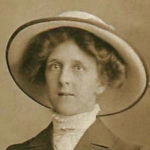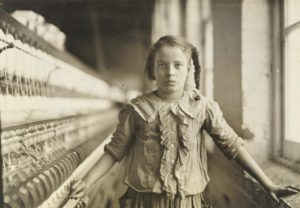
Sarah Elizabeth was born in 1888, the fourth of five children born to James and Mary Ann Sutton. Her father was a stone quarry man but her mother ruled the household. While James was Church of England, Mary Ann and her sister Rhoda were devoted to the Salvation Army which they had joined as young women. They had even been on the front line of temperance-related skirmishes with local pub owners and their customers: using the long hat pins of the day to defend themselves and their fellow Salvationist.
Mary Ann was a Salvationist to her dying day and all her children were raised in the Army. She was reputed to administer discipline with vigour and a leather strap. As her granddaughter Olive recalled, ‘Grandma’s rules were to her quite definitely in the same class as the ones God gave Moses, and had to be obeyed. People who did not obey Grandma were doomed to everlasting fire and as Satan was always on the look out for fuel she was determined that none of her family were going that way, and she was a very large determined lady!’
The Labour Exams
Various pieces of legislation from 1870 onwards had established public provision for the education of the working class. The syllabus concentrated on the ‘three Rs” of reading, writing and arithmetic plus needlework for girls. By 1899 the school leaving age was 12.¹
Therefore, unlike her mother who had worked on her Uncle’s farm from the age of seven, Sarah Elizabeth went to school until she was 11 years old, after which she started going out to work for half days. At 12, after passing the labour exam, she started work full time. As Sarah Elizabeth’s daughter, Olive, described:
’They had an exam at 11 to see if they were educated enough to go out to work half days. One week it was work 6am-12.15pm, school 2pm-4pm, the next school 9am-12noon, work 1.15pm-6pm. At 12 they took the full labour exam and went to work full time. The full exam meant knowing all the counties in the British Isles, the rivers, hills, headlands and bays, reading a simple paragraph, handwriting, small sums, and ‘parsing’. Mother parsed ‘At the back of the house John’s countenance fell a little’ and also recited ‘How Horatio kept his bridge’. All this was learned parrot fashion without regard to its meaning, and everyone passed.’

The Cotton Mills
Therefore, by the time Sarah Elizabeth was married to Frank Whitehead, she had been working for 14 years. In the census of 1901, she is recorded, age 12, as being a ‘doffer’: one of many nimble children responsible for replacing full doffs (spindles) with empty ones on cotton spinning frames. Apart from her parents and youngest brother Fred, who was 11 years old, the whole household worked in the cotton mills. Eliza Ann, the eldest, and Aunt Rhoda both wove a heavy cloth known as fustian while Abram and Willie (17 and 15 respectively) were piecers, responsible for repairing broken thread as it was spun.
By the census of 1911, Mary Ann had become a widow and Eliza Ann had married and left home. The family now lived at 56, Farrow Street in Shaw, in a three bedroomed house that Mary Ann owned. All the other children were still working in the cotton mills. Sarah Elizabeth, now 22 years old, was a ‘slubber tender’. Slubbing machines drew out and loosely twisted ‘sliver’ to make ‘roving’. Spinning mules took ‘roving’ and produced yarn. Abram, now engaged to Rebecca, had been promoted to become a ‘spinning room joiner minder’ where he would have been responsible for the quality and quantity of the yarn his spinning mules produced from ‘roving’. He would have been supported by two ‘piecers’ – possibly his brothers, whose jobs were recorded as such. Aunt Rhoda still lived with the family and, at 49, was now a char woman.
When Frank joined the Army in 1917, Sarah Elizabeth, together with her sister-in-law Rebecca, went back to work, this time in the Lily Mill in Shaw. Her daughter Olive was sent to live with her grandmother, Mary Ann, and Aunt Rhoda.
References & further reading
¹ ‘Education in England: A Brief History’ (chapter 3) By Derek Gillard

